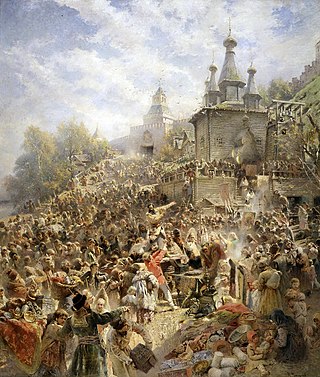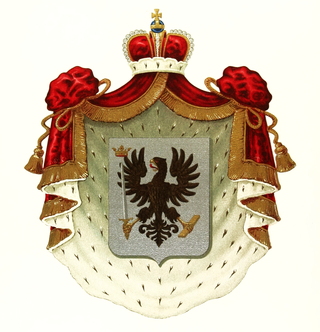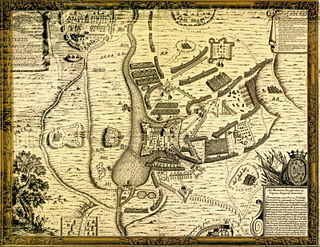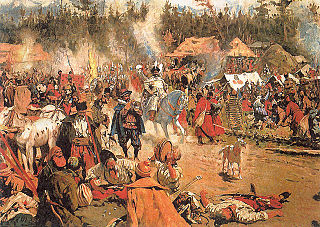
Bohdan Zynoviy Mykhailovych Khmelnytsky was a Ruthenian nobleman and military commander of Ukrainian Cossacks as Hetman of the Zaporozhian Host, which was then under the suzerainty of the Polish–Lithuanian Commonwealth. He led an uprising against the Commonwealth and its magnates (1648–1654) that resulted in the creation of an independent Cossack state in Ukraine. In 1654, he concluded the Treaty of Pereiaslav with the Russian Tsar and allied the Cossack Hetmanate with Tsardom of Russia, thus placing central Ukraine under Russian protection. During the uprising the Cossacks led a massacre of thousands of Poles and Jews during 1648–1649 as one of the most traumatic events in the history of the Jews in Ukraine and Ukrainian nationalism.

Stepan Timofeyevich Razin, known as Stenka Razin, was a Don Cossack leader who led a major uprising against the nobility and tsarist bureaucracy in southern Russia in 1670–1671.

The Time of Troubles, also known as Smuta, was a period of political crisis in Russia which began in 1598 with the death of Feodor I, the last of the House of Rurik, and ended in 1613 with the accession of Michael I of the House of Romanov.

Prokopy Petrovich Lyapunov was a prominent 17th century Russian nobleman (dvoryanin), voivode of, allegedly, a Rurikid origin who practically became a head of Pereyaslavl-Ryazansky lands nobility in the end of 1590s; he took part in wars during power vacuum in succession crisis that happened in early 1598 in Tsardom as result of confusion about legitimate heir apparent following death of Feodor I, nobility infighting, war declared by Polish–Lithuanian Commonwealth (PLC) in 1605, and exhaustive Tatar raids; most famously he is remembered for organizing and leading the first unsuccessful uprising against occupation of Moscow of 1610 by PLC in April of 1611.
Ivan Isayevich Bolotnikov headed a popular uprising in Russia in 1606–1607 known as the Bolotnikov Rebellion. The uprising formed part of the Time of Troubles in Russia.

The Russo-Polish War of 1654–1667, also called the Thirteen Years' War, Muscovite War of 1654-1667 and the First Northern War, was a major conflict between the Tsardom of Russia and the Polish–Lithuanian Commonwealth. Between 1655 and 1660, the Swedish invasion was also fought in the Polish–Lithuanian Commonwealth and so the period became known in Poland as "The Deluge" or Swedish Deluge.
The Battle of Konotop or Battle of Sosnivka was fought between a coalition led by the Hetman of Ukrainian Cossacks Ivan Vyhovsky and cavalry units of the Russian Tsardom under the command of Semyon Pozharsky and Semyon Lvov, supported by Cossacks of Ivan Bezpaly, on 29 June 1659, near the town of Konotop, Ukraine, during the Russo-Polish War (1654–1667). Vyhovsky's coalition defeated the Russians and their allies and forced the main Russian army to interrupt the siege of Konotop. However, the result of the battle only intensified political tensions in Ukraine and led to Vyhovsky's removal from power several months later.

The Russian conquest of Siberia took place during 1580–1778, when the Khanate of Sibir became a loose political structure of vassalages that were being undermined by the activities of Russian explorers. Although outnumbered, the Russians pressured the various family-based tribes into changing their loyalties and establishing distant forts from which they conducted raids. It is traditionally considered that Yermak Timofeyevich's campaign against the Siberian Khanate began in 1580. The annexation of Siberia and the Far East to Russia was resisted by local residents and took place against the backdrop of fierce battles between the Indigenous peoples of Siberia and the Russian Cossacks, who often committed atrocities against Indigenous Siberians.

Prince Alexander Ivanovich Chernyshyov, General of Cavalry (1827), was a Russian military leader, diplomat and statesman, whose career began in the Napoleonic Wars. After the Battle of Austerlitz (1805), he carried out successful diplomatic missions to France and Sweden and served with distinction in battles of 1812 and 1813. Chernyshyov rose through the ranks to the role of Russian Minister of War (1827–1852), chairman of the State Council and Cabinet of Ministers (1848–1856), and acquired the styles from Count (1826) to Serene Prince (1849).

The siege of Kromy was the last major clash of government troops of Boris Godunov with the rebel army of False Dmitry I.

The battle of the Bear's Ford took place in June 1608, when a government army of Boyar Ivan Kurakin defeated Lithuanian Colonel Alexander Lisowsky, in service of False Dmitry II.

In the Battle of Bolkhov on May 10–11, 1608, the troops of False Dmitry II managed to defeat the army of Tsar Vasily Shuisky.

The Battle of Kozelsk was the first victory of False Dmitry II against the government of Tsar Vasili IV Shiuski.

The siege of Moscow was the last major military action of Wladyslaw IV's campaign of 1617–1618 and the entire Polish-Muscovite War (1605–1618). During the short siege, which lasted several weeks in the autumn of 1618, an assault of the city was unsuccessful. Having failed, the Polish-Lithuanian government went to the conclusion of the Truce of Deulino.

The Battle of Mozhaysk was a series of battles at the final stage of the Polish-Muscovite War (1605–1618) on the western approaches to Moscow. The battle is part of the Moscow campaign of Wladyslaw IV. During months of fighting, the Russian armies managed to maintain their combat capability and prevent the rapid seizure of Moscow. However, the threat of encirclement forced the Russian troops to retreat, opening the way for the enemy to the capital.

Battle of Simbirsk in 1670 was a decisive battle of Stepan Razin's rebellion.

The siege of Moscow (1606) was a siege of Moscow by the detachments of Ivan Bolotnikov in the fall of 1606, during the Time of Troubles.

The Tushino Camp was the camp of False Dmitry II near the village of Tushino near Moscow, which from June 1608 to December 1609 served as the capital of this impostor, who, as a result, received the name "Tushino Thief". All those dissatisfied with the elected Tsar Vasily Shuisky, flocked to the Tushino Camp, which made it a shadow capital with its own state institutions, a patriarch, and so on. From December 1609 to March 1610, the Tushino Camp supported the Polish King Sigismund.

The Great Northern War in Ukraine (1708–1713) — war between the Tsardom of Russia on one hand and the Swedish Empire and the Ottoman Empire on the other.

The march of the Polish prince and Tsar of Russia Władysław IV Vasa on Moscow — a military conflict between the Polish-Lithuanian Commonwealth and the Tsardom of Russia, which lasted from 1617 to 1618. During this conflict, the crown and Lithuanian troops, as well as the Zaporozhian Cossacks fought for prince Władysław IV Vasa becoming the Tsar of Russia. The war ended with the signing of the Truce of Deulino. It is considered the final stage of the Polish–Muscovite War (1609-1618).














